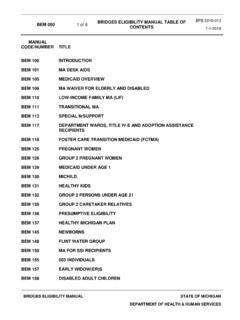Transcription of MORE Table of Contents THAN A MEAL
1 99 Massachusetts Department of Education Child and Adult Care Food ProgramIT S MORETHAN A MEALC ultureandFoodTable of ContentsIntroduction .. 101 Why Consider Culture? .. 102 Culturally Sensitive Interactions .. 103103 .. Cultures Have Different Stylesof Communication104 .. Build Communication Bridgeswith Participants and Families104.. Create Open Dialogues About Foods105 .. LEARN to Negotiate Solutionsin a Culturally Sensitive WayCultural Foods ..106109 .. Caribbean:Cuba, Dominican Republic,Haiti, Jamaica, Puerto Rico107.. South American:Brazil108 .. European:Ireland, Italy, Poland,Portugal, Russia113 .. Middle Eastern:Bahrain, Egypt, Iran,Iraq, Israel, Jordan, Kuwait, Lebanon,Oman, Saudi Arabia, Syria, Turkey,The United Arab Emirates, Yemen114.
2 West African:Benin, Burkina Faso,Cape Verde, Gambia, Ghana, Guinea,Guinea Bissau, Ivory Coast, Mali,Mauritania, Niger, Nigeria, Senegal,Sierra Leone, Togo115.. Asian:China, India, Japan118 .. Southeast Asian:Burma, Cambodia,Laos, Thailand, VietnamSources of Informationon Culture and Food .. 119100 Nutrition resource manual for Adult Day Health ProgramsDeveloped for the Massachusetts Department of Education Child and Adult Care Food Program by the University ofMassachusetts Extension Nutrition Education Program. 2006 Massachusetts Department of Education. Permission is herebygranted to copy any or all parts of this document for non-commercial educational purposes.
3 Please credit the MassachusettsDepartment of Education. 101 Massachusetts Department of Education Child and Adult Care Food ProgramCULTURE AND FOODThis section will cover the following topics:Why Consider Culture?What cultural trends are occurring in the population of older adults?Why is it important to consider issues involving culture and diversity?Culturally Sensitive InteractionsHow can you interact with participants and staff in a culturally sensitive way?Learn some tips that focus on: recognizing that different cultures may have different styles of communication building communication bridges with people from diverse cultures creating dialogues about food learning to negotiate solutions in a culturally sensitive wayCultural FoodsWhat are some foods and eating patterns of cultures in different parts of the world?
4 This section willfeature foods commonly consumed in the Caribbean, South America, Europe, Middle East, West Africa,Asia, and Southeast Asia. Although the examples are not comprehensive, they may help you identifysome foods that may be common to certain :The purpose of this section is to stimulate awareness of cultural groups and respect for and acceptance of these following tips and examples are not meant to stereotype cultures, favor any cultures at the exclusion of others, or implythat all people from the same culture are identical. Food groupings in this section may differ from food groupings of the CACFP meal section will address traditionalcommunication styles and eatingpatterns that may be common in resource manual for Adult Day Health ProgramsIT SMORETHAN A MEALThe population of older adults in the UnitedStates is becoming more culturally diverse.
5 Asa result, adult day health programs are morelikely to be serving participants from a varietyof cultures and ethnic backgrounds. The concept of culture is broader than raceor ethnicity. It also encompasses language,communication styles, social values, and religiousbehaviors. Culture shapes how people view theworld, their attitudes about health, and theirfood preferences. Cultural cuisines reflect the geography, climate,and history of the location where the culturedeveloped. Within each culture (and withindifferent regions where the culture is dispersed),people may prefer certain foods, food preparationmethods, and food combinations for mealsand in mind that diversity within cultures is asimportant as diversity between cultures.
6 Peoplefrom the same cultural or ethnic group tend tohave had some similar experiences. Within eachgroup, however, individuals may vary in terms ofincome, social class, religion, age, education,geographic origin, and the length of time thatthey have lived in the United to this diversity within cultures, you cannotassume that all members of a culture share thesame communication styles, health beliefs, andfood preferences. General knowledge of culturaldifferences can provide a starting point fordiscussions about foods and people fromdiverse cultures. Why Consider Culture?84% Caucasian8% Non-Hispanic Black6% Hispanic2% Asian/Pacific Native Government, 2000 CensusRACIAL/ETHNIC BACKGROUNDS OFAMERICANS AGED 65 AND OLDER103 Massachusetts Department of Education Child and Adult Care Food ProgramCULTURE AND FOOD Interactions with culturesprefer a non-confrontational style.
7 Othersvalue a more assertive style of interaction. Expression of cultures preferto directly express their emotions. Othersfeel that directly expressing emotions isconfrontational, and prefer to indirectlyexpress or mask their emotions. Disclosure of culturesare hesitant to disclose personal or familyinformation to a stranger. Others are morewilling to do so. Volume of cultures preferspeaking in a soft tone. Others prefer astronger tone of voice. cultures are comfortable withlong periods of silence in a consider it appropriate to speakbefore another person has finished talking. Eye cultures prefer lookingpeople straight in the eye.
8 Others considerthis to be rude, disrespectful, or a signof hostility. Physical cultures are comfortablewith close body space. Others are morecomfortable standing or sitting at a greaterdistance from each other. Body cultures perceivevigorous handshaking as aggressive, whileothers consider it a gesture of cultures perceive finger-pointing orfoot-pointing as disrespectful, while othersconsider these gestures to be benign. Somecultures perceive arm-waving as friendly,while others consider it a sign of contempt. Gender cultures have traditionalrole expectations based on gender. Othersare more flexible about gender roles. Perception of cultures valuepromptness.
9 Other cultures are less orientedaround being on time. Source:Elizabeth Randall-David. Strategies for Workingwith Culturally Diverse Communities and Clients. Office ofMaternal and Child Health, Department of Health andHuman Services, Sensitive InteractionsCULTURES HAVE DIFFERENT STYLES OF COMMUNICATION They may vary in terms of these commonly accepted communication practices:104 Nutrition resource manual for Adult Day Health ProgramsIT SMORETHAN A MEALBUILD COMMUNICATION BRIDGES WITHPARTICIPANTS AND FAMILIESC ulturally sensitive communication skills canallow for more rewarding interactions withparticipants and their families.
10 Here are sometips to enhance your skills:Arrange for a Comfortable Meeting Schedule enough time so that no onefeels rushed and you can address anycommunication barriers. Encourage family members to chooseseating that provides a comfortable degreeof personal space and eye a Personal Approach Smile, show warmth, and be friendly. Learn the greetings and titles of respectused in their languages. Ask the participant and family how theyprefer to be addressed. Speak clearly and in a normal volume. When interacting with people with limitedEnglish-speaking skills, keep in mind thattheir limited use of the English language isnot a reflection of their intellectual abilities,or of their ability to communicate effectivelyin their own Misinterpretations ofYour Words or Intentions Avoid using slang, metaphors, and otherexpressions that may be hard to understand.








